Skills Tracking Software
The ready-to-use system of truth
Our platform provides a best-in-class skills tracking software. Don’t let your skills and competency data remain unused inside a spreadsheet. Get the ability to create or extend your competency frameworks, customize job profiles, assign learning and development options, govern workflow and collaborate with other talent management applications.
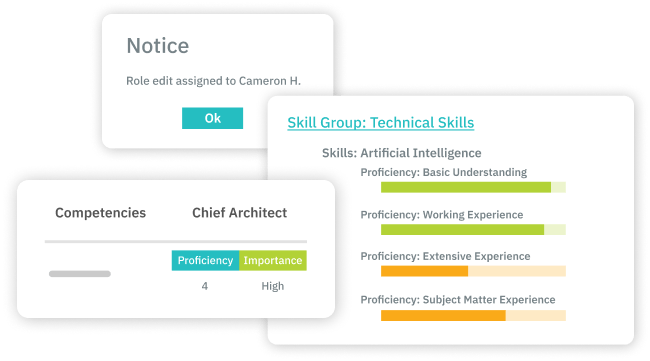
Skills Tracking Software
Our platform provides cutting-edge skills tracking software tailored to meet the needs of modern HR teams. Don’t let valuable skills and competency data remain buried in spreadsheets. With our solution, you can effortlessly build or expand competency frameworks, customize job profiles, assign focused learning and development plans, and manage workflows with ease.
By mastering skills tracking, your organization can identify employees’ capabilities and monitor their progress in completing training programs. By centralizing workforce skills data, you can create a comprehensive skills repository that helps you evaluate how employees’ skills align with job requirements.
A robust job skills database also highlights training gaps across your workforce and pinpoints areas for growth, either at the department level or for individual employees. Additionally, it helps establish clear career progression paths for those focused on advancing their professional development.
Our software seamlessly integrates with your existing talent management systems, allowing cross-department collaboration and enabling data-driven decisions that enhance performance, retention, and employee development. See how our skills tracking software can position your organization to stay competitive in today’s fast-evolving talent landscape.
To learn more, please request a demo.
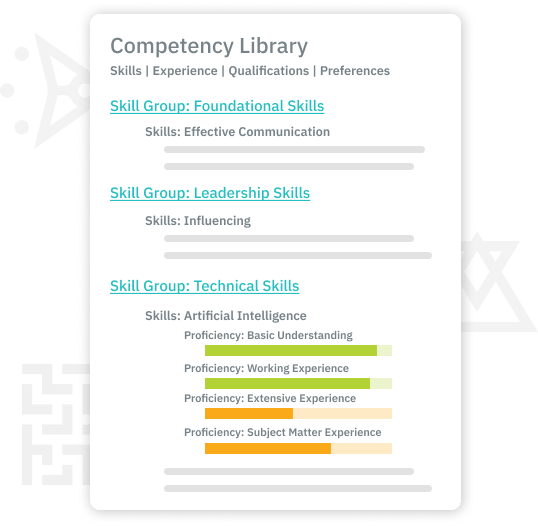
Create and Manage Skills
Our skills database streamlines HR administrative tasks by allowing you to easily create, edit, and compare multiple competencies—such as skills, experiences, qualifications, and preferences—required for various job functions. This functionality simplifies the management of workforce data, enabling HR teams to quickly assess competency requirements, identify gaps, and ensure that job profiles are accurately aligned with business needs. By automating these processes, the skills database reduces administrative burden, improves efficiency, and helps HR teams make more informed decisions regarding talent development and recruitment.
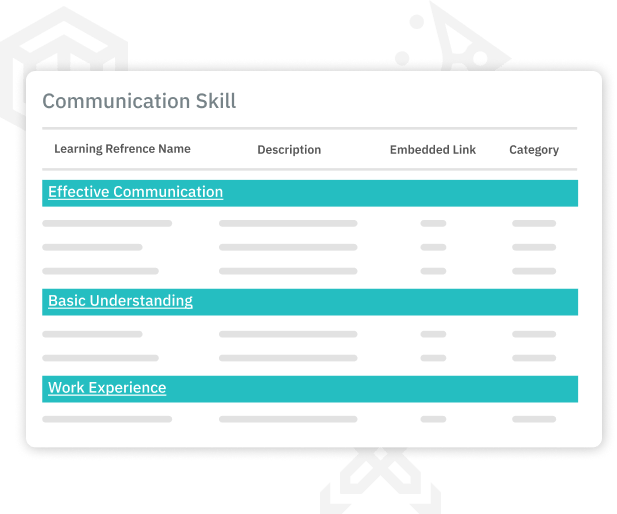
Map Competencies to Jobs
Our platform enables HR teams to seamlessly map competencies to job profiles, ensuring that roles, responsibilities, and skill expectations are aligned across all job levels—from entry-level positions to executive roles. This feature allows HR professionals to maintain consistency in expectations, making it easier to identify skill gaps, set clear development goals, and ensure employees are equipped with the right skills to succeed. By aligning competencies with job profiles, HR teams can improve talent management, streamline recruitment, and create clear pathways for career progression, ultimately boosting workforce performance and engagement.
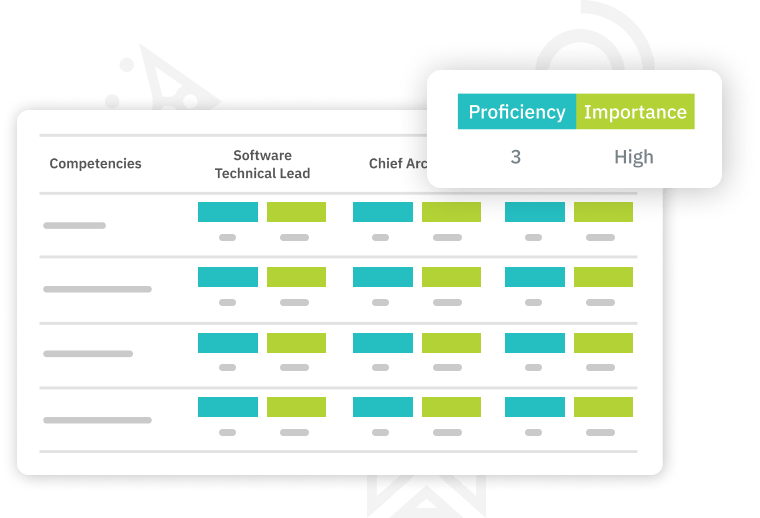
Calibrate Job Profiles across Job Families
Our platform empowers HR teams with the ability to calibrate job profiles across one or multiple job families, ensuring standardization and consistency across the entire job catalog. With job profile calibration, HR can fine-tune the level of proficiency and importance of competencies for each job profile and grade level. This ensures that expectations are aligned across roles, making it easier to compare job requirements, set clear performance benchmarks, and manage career progression. By standardizing job profiles, HR teams can drive consistency in talent management, improve internal mobility, and ensure that the right skills are in place at every level of the organization.
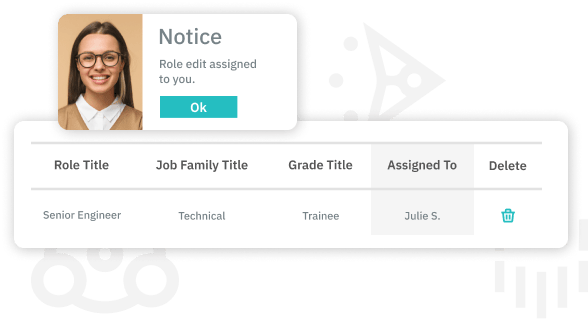
Govern
Our platform provides HR teams with the tools to seamlessly govern job role data by managing entitlements, rules, roles, and policies. This ensures that job data is consistently accurate, secure, and compliant with organizational standards. With the ability to control access and maintain governance over job role information, HR can efficiently manage job profiles, ensure policy adherence, and reduce data discrepancies across the organization. This level of governance helps streamline talent management, enhance data integrity, and support informed decision-making.
Get Your Free Demo & See our Platform in Action
Select from one of the bundles below and we will tailored the demo to your needs. Let us show you how TalentGuard’s solutions adapt to your industry.
Automate
Create skill profiles, create detailed job descriptions, align learning content with specific skills, and chart clear career path progressions to set the foundation for effective talent management.
Automate includes:
- Create Skill and Competency Profiles
- Develop Job Descriptions
- Map Learning to Skills and Competencies
- Map Career Path Progressions
Assess
Effectively assess their employees’ skills, identify gaps, and implement strategies to develop a skilled and competent workforce prepared to meet current and future challenges.
All the Automate features plus the ability to:
- Create a Skills Inventory
- Conduct Gap Analysis
Engage
Organizations can significantly enhance their talent development strategy and workforce effectiveness by assessing employee skills, curating personalized learning paths, recommending appropriate career paths, and tracking career goals.
All the Automate features plus the ability to:
- Assess Employee Skills and Competencies
- Curate Personalized Employee Learning Paths
- Recommend Employee Career Paths
- Track Career Goals
Optimize
Building talent pools, measuring employee performance, tracking certifications, and conducting multi-rater feedback enhance talent management, ensure compliance, and foster organizational leadership development.
All the Engage features plus the ability to:
- Build Talent Pools
- Measure Employee Performance
- Track Employee Certifications
- Conduct Multi-Rater Leadership Feedback
Trusted by:




Your workforce is changing. Never be unprepared again.
Read our eBook
Is a Skills Tracking Software Necessary for Your Business?
As industry expectations shift, skills software is needed to keep your workforce aligned. Skills tracking software ensures that no one is left behind by monitoring progress and identifying gaps, so every employee stays up-to-date with the required skills.
With today’s educational methods, many companies use eLearning or a hybrid model for training employees. Employee skill matrix charts can be used to track which employees have completed the online portion of their eLearning since it is often separate from any in-person group training events. While eLearning allows a more flexible learning timeline, it also makes it much harder to know who is up to date on their required professional development. As employees complete the virtual training sessions, the skills tracking software is updated to provide a clear picture of who needs additional prompting.
Additionally, there is a need for the software to also determine the competency level for each employee. When assumptions are made based on training hours or employee perspective alone, then some employees will look more skilled and experienced than they really are. If your skills tracking software is going to be any good, it has to catch skills gaps where employees aren’t truly equipped to perform a skill, despite training or real-world experience.
Skill Matrix Example
Before skills tracking software, an employee skill matrix chart was created in an excel spreadsheet. Most companies would list the name of each employee, their role in the company and how proficient they were at a given skill. Some companies would use terms (basic, competent, advanced, expert) on their skills matrix excel sheet, while other companies might use a number scale to clarify capabilities. All of this information was updated manually, typically by HR managers when they were notified by department heads.
In today’s world, keeping up with spreadsheet updates is highly inefficient. Not only will a manual data entry waste an employee’s time, but it is more likely to contain errors and provide outdated information. With a sole document tracking the numbers, it is also easy for companies to have outdated copies still floating around.
Current skill matrix examples are automated to update as employees complete training. Top employee skill matrix software makes the process more efficient and provides more accurate data. Not only should current technology make it easier to track data, but it also enables fast and accurate reporting. Visual reports clarify where employee workforce gaps exist and training is needed.
Plus, today’s skills tracking software makes it easy for department heads to check information at any time. Anyone with access to the software can see the updates to the platform without needing the latest copy of a document.
Skills Management Software
A skills and competency management software is similar to skills tracking software. Skills management software is used to house all skills data for your workforce in order to apply that data throughout other talent management practices. The best skills management software will update skills as they change and understand the skills, experiences, capabilities and proficiencies required to do a job well.
This software helps leaders look at the ability levels of their teams from a centralized library. With an overarching database to manage skills tracking, leaders can map out skills needed to improve individual employees. It is important to pinpoint areas where professional development could enable a company to scale more effectively, offer additional services or better match customer demand. It makes it easier for HR leaders to see what skills are missing within the company, improving the hiring process by targeting talent to fill skill gaps.
Skills management software typically integrates with other important software for HR leaders, including performance management software, competency assessment software and learning management systems (LMS). This seamless integration makes it easier for executives and upper management to compile important data and update their results continuously through automation.
Competency Assessment Software
Competency assessment software is used to assess how an employee evaluates his or her skill compared to how their manager views them. It is important to understand if there is any disconnect between what the employee sees and what leadership experiences. Some employees believe they are capable when the managers determine they are inexperienced. In other cases, management may not realize a skill set that an employee has because it hasn’t been tested.
In some cases, skills gap analysis software may not catch a lack of proficiency. For example, an employee could take a course on a specific skill but not pick up enough of the information to display competency. While the skills tracking software might initially see the training as completed, the competency assessment software would provide greater insight into the true nature of those skills.
When there is a gap between the two evaluations, skill gap analysis software is used to determine the difference between the current state of competency and the desired level of competency for a given skill. The employee can then develop further in order to meet the benchmarks required for the skill in question.
Organizations need a platform that can manage all of these areas in order to operate effectively. A company is only as strong as the workforce it can put together and keep engaged. With the latest technology to help monitor employee capabilities, leadership can form the strongest team possible.
